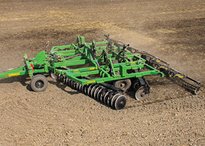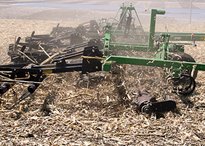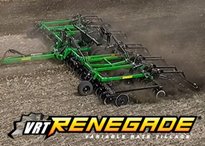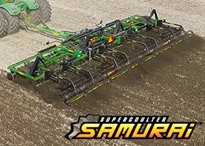Four Uses for Land Rollers
When we bring a SuperRoller to trade shows, one of the most common questions people ask is, “What does that thing do?” However, there isn’t an easy answer, because land rollers actually have several uses. To give you a better idea, here are four of the most popular ways our customers have experienced success with land rollers:
1. Reduce Debris Uptake During Harvest
 This is the most common use for land rollers. If you’re farming an area with lots of rocks or tough root balls, we recommend using a land roller soon after planting soybeans or other low-to-the-ground crops (basically, anything that is harvested with a flex head). The roller will push those solid objects into the ground, so they don’t get picked up by the combine header later. Keeping the rocks and root balls out will help prevent costly damage and downtime to the combine during harvest. It can also reduce the amount of dirt taken up by the combine, resulting in less wear-and-tear on the machine and a cleaner harvest (which could get you a higher price at the elevator).
This is the most common use for land rollers. If you’re farming an area with lots of rocks or tough root balls, we recommend using a land roller soon after planting soybeans or other low-to-the-ground crops (basically, anything that is harvested with a flex head). The roller will push those solid objects into the ground, so they don’t get picked up by the combine header later. Keeping the rocks and root balls out will help prevent costly damage and downtime to the combine during harvest. It can also reduce the amount of dirt taken up by the combine, resulting in less wear-and-tear on the machine and a cleaner harvest (which could get you a higher price at the elevator).
2. Increase Seed-To-Soil Contact Using a land roller after planting doesn’t just help with rock management…It also firms the soil, thereby increasing seed-to-soil contact. This increased seed-to-soil contact promotes quicker emergence, which we’ve experienced firsthand in our own fields. In fact, we’ve conducted side-by-side testing, which has shown a yield increase of one to two bushels per acre in soybeans by land rolling.
Using a land roller after planting doesn’t just help with rock management…It also firms the soil, thereby increasing seed-to-soil contact. This increased seed-to-soil contact promotes quicker emergence, which we’ve experienced firsthand in our own fields. In fact, we’ve conducted side-by-side testing, which has shown a yield increase of one to two bushels per acre in soybeans by land rolling.
Some of our customers have been so convinced by this benefit that they’ve started rolling other seeds besides beans. For instance, we’ve seen people follow corn planters with their land rollers to help boost emergence, especially in areas with short growing seasons.
3. Strengthen Soybeans
In soybeans, some people like to use land rollers during an early growth stage, generally before the beans have developed their fourth trifoliate leaves. This slightly stresses the plants, encouraging better root growth and helping the plants grow back more vigorously than before.
4. Manage Residue
 Land rollers can actually help manage residue by shattering and breaking down tough corn stalks. They also fracture corn root ball structures while they’re still in the ground to aid in residue decomposition. This practice is often used by no-tillers after corn harvest as a way to deal with challenging residue without reverting to tillage.
Land rollers can actually help manage residue by shattering and breaking down tough corn stalks. They also fracture corn root ball structures while they’re still in the ground to aid in residue decomposition. This practice is often used by no-tillers after corn harvest as a way to deal with challenging residue without reverting to tillage.
How to Get Started
If you’re interested in trying one of these approaches for yourself, one of the best ways to get started is to rent a neighbor’s land roller. If there aren’t any land rollers currently being used in your area, it could be a great opportunity for you to be the first one. Oftentimes, after one farmer purchases a land roller, it generates a lot of interest in the community. Others may start asking to rent the land roller and, before you know it, the unit is paid off and you’ve got a new source of income.




























 Hats, Diecast Models, Gloves and More!
Hats, Diecast Models, Gloves and More!
 Library
Library